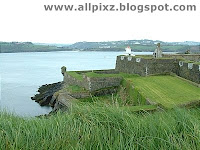
HISTORY OF IRELAND
The history of Ireland began with the first known settlement in Ireland around 8000 BC, when hunter-gatherers arrived from continental Europe, probably via a land bridge.[1] Few archaeological traces remain of this group, but their descendants and later Neolithic arrivals, particularly from the Iberian Peninsula, were responsible for major Neolithic sites such as Newgrange.[2][3] Following the arrival of Saint Patrick and other Christian missionaries in the early to mid-5th century AD, Christianity subsumed the indigenous Celtic religion by the year 600.
From around AD 800, more than a century of Viking invasions brought havoc upon the monastic culture and on the island's various regional dynasties, yet both of these institutions proved strong enough to survive and assimilate the invaders. The coming of Cambro-Norman mercenaries under Richard de Clare, 2nd Earl of Pembroke, nicknamed Strongbow, in 1169 marked the beginning of more than 700 years of direct Norman and, later, English involvement in Ireland. The English crown did not begin asserting full control of the island until after the English Reformation, when questions over the loyalty of Irish vassals provided the initial impetus for a series of military campaigns between 1534 and 1691. This period was also marked by an English policy of plantation which led to the arrival of thousands of English and Scottish Protestant settlers. As the military and political defeat of Gaelic Ireland became more clear in the early seventeenth century, the role of religion as a new division in Ireland became more pronounced. From this period on, sectarian conflict became a recurrent theme in Irish history.
The overthrow, in 1613, of the Catholic majority in the Irish parliament was realised principally through the creation of numerous new boroughs, all of which were Protestant-dominated. By the end of the seventeenth century all Catholics, representing some 85% of Ireland's population then, were banned from the Irish parliament. Political power rested entirely in the hands of an Anglo settler-colonial, and more specifically Irish Anglican, minority while the Catholic population suffered severe political and economic privations. In 1801, the Irish Parliament was abolished and Ireland became an integral part of a new United Kingdom of Great Britain and Ireland under the Act of Union. Catholics were still banned from sitting in that new parliament until Catholic Emancipation was attained in 1829, the principal condition of which was the removal of the poorer, and thus more radical, Irish freeholders from the franchise.
The Irish Parliamentary Party strove from the 1880s to attain Home Rule self-government through the parliamentary constitutional movement eventually winning the Home Rule Act 1914, though suspended on the outbreak of World War I. In 1922, after the Irish War of Independence and the Anglo-Irish Treaty, the larger part of Ireland seceded from the United Kingdom (UK) to become the independent Irish Free State — and after 1948 the republic, Ireland. The six north eastern counties, known as Northern Ireland, remained within the United Kingdom. The Irish Civil War followed. The history of Northern Ireland has since been dominated by sporadic sectarian conflict between (mainly Catholic) Nationalists and (mainly Protestant) Unionists. This conflict erupted into the Troubles in the late 1960s, until an uneasy peace thirty years later.






























.jpg)








.png)







No comments:
Post a Comment